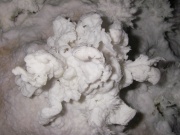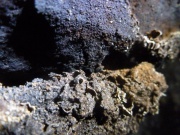Hydromagnesite (Inventory)/Crinkle Blister
From LagWiki
(Difference between revisions)
| Line 3: | Line 3: | ||
The '''Crinkle Blister''' field should be used to record stations which exhibit cave blisters. | The '''Crinkle Blister''' field should be used to record stations which exhibit cave blisters. | ||
| - | Crinkle Blisters are thin, hollow balls that form on cave walls and other speleothems. Even though this field appears under the [[Hydromagnesite (Inventory)| | + | Crinkle Blisters are thin, hollow balls that form on cave walls and other speleothems. Even though this field appears under the [[Hydromagnesite (Inventory)|hydromagnesite]] section of the ''CCNP Cave Inventory Form'', most blisters are made of [[Calcite (Inventory)|calcite]] or [[Gypsum (Inventory)|gypsum]]. Any blisters found should be recorded here no matter their composition which may be difficult to determine, anyway. Most crinkle blisters are rarely more than a few centimeters in diameter. They can sometimes appear as curling flakes. The thickness of the walls can range from half a millimeter to almost one centimeter. They are formed from pasty minerals which have dried. They sometimes appear in blobs like shaving cream. |
===References=== | ===References=== | ||
Revision as of 00:42, 21 April 2011
The Crinkle Blister field should be used to record stations which exhibit cave blisters.
Crinkle Blisters are thin, hollow balls that form on cave walls and other speleothems. Even though this field appears under the hydromagnesite section of the CCNP Cave Inventory Form, most blisters are made of calcite or gypsum. Any blisters found should be recorded here no matter their composition which may be difficult to determine, anyway. Most crinkle blisters are rarely more than a few centimeters in diameter. They can sometimes appear as curling flakes. The thickness of the walls can range from half a millimeter to almost one centimeter. They are formed from pasty minerals which have dried. They sometimes appear in blobs like shaving cream.
References
- Palmer, Arthur N. (2007) Cave Geology CAVE BOOKS, Dayton, OH p 293 ISBN-13: 978-0-939748-66-2, ISBN-10: 0-939748-66-5


